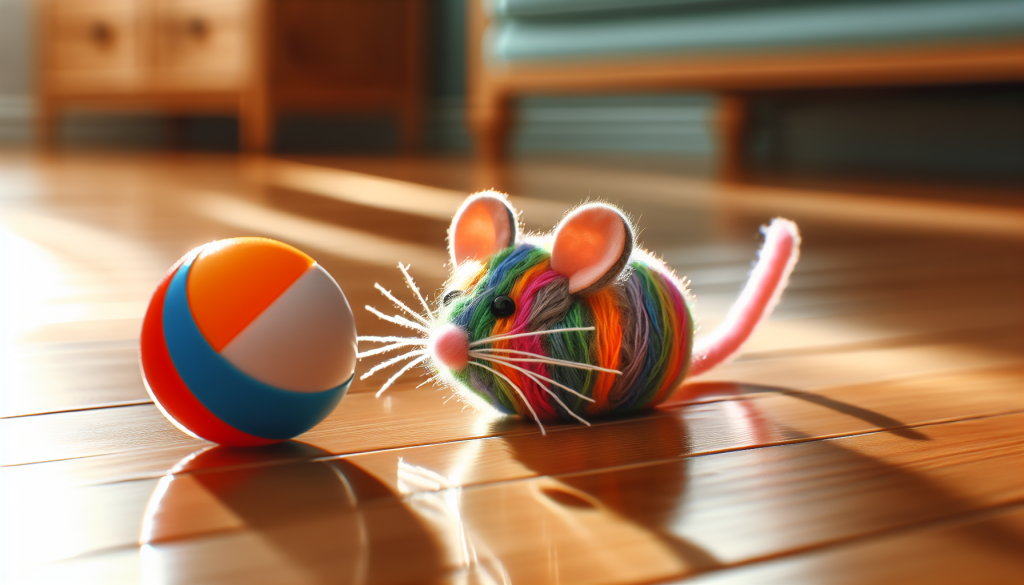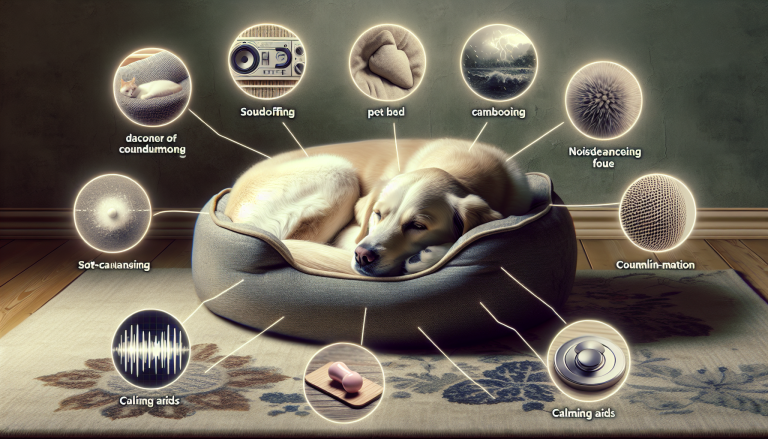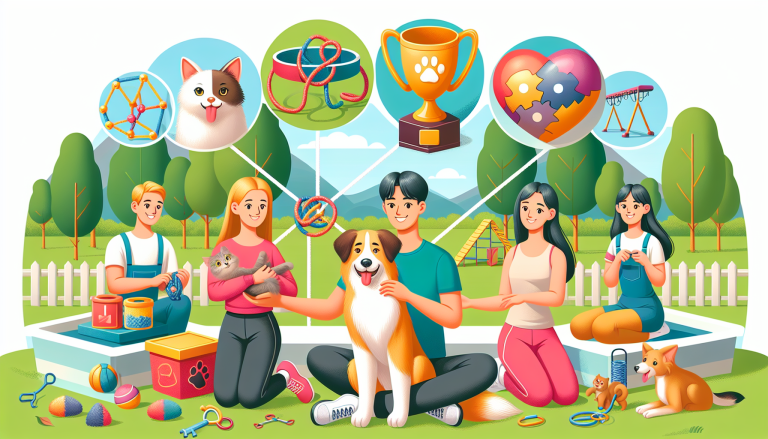Whether you’re a new pet owner or a seasoned pro, keeping your furry friend healthy and happy is a top priority. From regular exercise to a balanced diet, there are a multitude of ways you can ensure your pet’s well-being. In this article, we’ll explore the top ways to keep your pet healthy and happy, providing practical tips and expert advice that will have tails wagging and purrs flowing in no time.
Table of Contents
ToggleDiet and Nutrition
Choose a Balanced Diet
When it comes to keeping your pet healthy and happy, choosing a balanced diet is crucial. Make sure to provide your furry friend with a diet that includes a proper balance of proteins, carbohydrates, essential fats, vitamins, and minerals. Consult with your veterinarian to determine the specific nutritional needs of your pet, as certain breeds and ages may require different dietary requirements. Consider selecting high-quality pet food that meets the standards set by reputable organizations.
Provide Fresh Water
In addition to a balanced diet, fresh water is essential for your pet’s overall well-being. Ensure that your pet has access to clean water at all times, especially during hot weather or after physical activities. Regularly change the water in their bowls to maintain freshness and prevent contamination. Consider investing in a water fountain designed for pets, as it can provide a constant supply of clean and filtered water, encouraging your pet to stay hydrated.
Avoid Table Scraps
Although it may be tempting to share your meals with your furry companion, it is important to avoid feeding them table scraps. Certain human foods can be toxic to pets or cause digestive issues. Additionally, table scraps can lead to obesity and imbalance in their diet. Stick to feeding your pet their specially formulated diet, and if you want to treat them, opt for pet-friendly treats that are safe and healthy.
Monitor Portion Sizes
Maintaining a healthy weight is crucial for your pet’s overall health. Just as with humans, overfeeding can lead to obesity, which can increase the risk of various health issues. It is important to monitor portion sizes and follow the feeding guidelines provided by your veterinarian or pet food manufacturer. If you are unsure about the appropriate portion size for your pet, consult with your veterinarian for personalized guidance. Regularly check your pet’s body condition and adjust their food intake accordingly.
Consult a Veterinarian
When it comes to your pet’s diet and nutrition, consulting with a veterinarian is highly recommended. They can provide you with valuable advice and guidance tailored to your pet’s specific needs. A veterinarian can help you determine the appropriate diet, portion sizes, and recommend any necessary nutritional supplements. Regular check-ups with a veterinarian will also ensure that any underlying health issues are identified and addressed promptly.
Regular Exercise
Engage in Daily Playtime
Regular exercise is essential for keeping your pet healthy and happy. Engage in daily playtime sessions with your furry friend to stimulate their physical and mental well-being. Play fetch, engage in interactive games, or let them chase toys to provide the exercise they need. The level of activity required may vary depending on your pet’s age, breed, and overall health, so consult with your veterinarian to determine the appropriate exercise routine for your pet.
Take Regular Walks
Taking your pet for regular walks is not only a great way to provide them with exercise but also an opportunity for them to explore the world around them. Dogs, in particular, require daily walks to maintain their physical health and mental stimulation. Consider varying your walking routes to keep things interesting for your pet. Remember to always use a leash to ensure their safety and follow any local regulations regarding pet walking.
Provide Mental Stimulation
In addition to physical exercise, mental stimulation is important for your pet’s overall well-being. Engage in activities that challenge their mind and keep them mentally sharp. Puzzle toys, treat-dispensing toys, and interactive games are great options to provide mental stimulation. Train your pet to learn new tricks or commands, as this can also help keep their minds active and enhance their bond with you.
Consider Agility Training
If you have an active and energetic pet, agility training can be a fantastic way to provide both physical and mental stimulation. Agility training involves navigating through a course of obstacles and can help improve your pet’s coordination, agility, and overall fitness. Consider enrolling in agility classes or set up an agility course in your backyard if space permits. Always ensure that the activities are safe and suitable for your pet’s age and physical abilities.
Use Interactive Toys
Interactive toys can be a great source of entertainment and mental stimulation for your pet. These toys are designed to keep your pet engaged and challenge their problem-solving skills. Look for toys that require your pet to figure out puzzles or dispense treats. By providing such toys, you can give your pet a fun and rewarding way to spend their time when you’re not available to play with them.
Routine Veterinary Care
Schedule Regular Check-ups
Routine veterinary care is essential for maintaining your pet’s overall health. Regular check-ups with a veterinarian will help detect any potential health issues early on and allow for timely intervention. During these appointments, your veterinarian will perform a thorough physical examination, check for common health concerns, and address any questions or concerns you may have regarding your pet’s well-being. Follow their recommended schedule for check-ups to ensure your pet stays in optimal health.
Follow Vaccination Schedules
Vaccinations play a vital role in protecting your pet from various diseases. Make sure to follow the recommended vaccination schedules provided by your veterinarian. Vaccinations can prevent life-threatening conditions and help build your pet’s immune system. Stay up-to-date with your pet’s vaccinations and keep a record of their vaccination history to ensure they receive the necessary boosters or updates as required.
Administer Preventive Medications
Parasites such as fleas, ticks, and worms can pose serious health risks to your pet. Administering preventive medications as recommended by your veterinarian is crucial to keep these parasites at bay. Flea and tick preventives, heartworm preventives, and regular deworming are some of the preventive measures you should discuss with your veterinarian. These medications are designed to protect your pet from parasites and ensure their well-being.
Dental Care
Dental care is often overlooked but is a crucial aspect of your pet’s overall health. Poor dental hygiene can lead to gum disease, tooth decay, and other oral health issues that can cause pain and discomfort. Regularly brushing your pet’s teeth with pet-friendly toothpaste and toothbrushes can help prevent the buildup of plaque and tartar. Additionally, consider providing dental treats or toys designed to promote good oral health. If needed, consult with your veterinarian for professional dental cleaning.
Spaying/Neutering
Spaying or neutering your pet offers several health benefits and can help prevent certain reproductive diseases and behavioral problems. Discuss with your veterinarian when it is the appropriate time to spay or neuter your pet. The procedure can help control the pet population and contribute to their overall well-being. Your veterinarian will guide you through the surgical process and provide the necessary aftercare instructions for a smooth recovery.
Maintaining a Clean Environment
Regularly Clean Indoor Spaces
Keeping your pet’s indoor spaces clean is important for their health and well-being. Regularly vacuuming and sweeping helps remove pet hair, dander, and other allergens from the environment. Pay attention to areas your pet frequents, such as their bed, favorite resting spots, and litter boxes. Use pet-safe cleaning products to ensure a hygienic environment without any harmful chemicals.
Maintain a Hygienic Pet Bed
Your pet’s bed is their sanctuary, and maintaining its cleanliness is crucial to prevent the buildup of dirt, parasites, and allergens. Wash their bed regularly using pet-friendly detergents and follow the manufacturer’s instructions. Consider using removable and washable bed covers for easy maintenance. Providing a clean and cozy sleeping area not only promotes their physical health but also enhances their comfort and overall well-being.
Keep Outdoor Areas Safe
If your pet spends time outdoors, it is important to ensure their environment is safe and secure. Regularly inspect your yard for any potential hazards or toxic substances. Secure any fences or gates to prevent your pet from escaping or encountering unfamiliar animals. Remove any poisonous plants from your garden that could be harmful if ingested. By taking necessary precautions, you can provide a safe and secure outdoor space for your pet to enjoy.
Avoid Harmful Chemicals
Pets are naturally curious, and they may come into contact with various household chemicals that can be toxic to them. Keep all cleaning supplies, pesticides, fertilizers, and other chemicals securely stored in cabinets or areas that are inaccessible to your pet. When using any chemicals, make sure your pet is in a separate and well-ventilated area to avoid potential exposure. Opt for pet-friendly and non-toxic products whenever possible to minimize risks.
Dispose of Waste Properly
Proper waste disposal is not only essential for a clean environment but also for preventing the spread of disease and maintaining good hygiene. Always pick up after your pet when they eliminate, whether it’s in your yard or during walks. Use biodegradable bags to dispose of waste and properly seal them before discarding. If you have a cat, make sure to clean and maintain their litter box regularly to prevent odor and bacterial buildup.
Grooming and Hygiene
Brushing and Bathing
Regular brushing and bathing are important aspects of maintaining your pet’s hygiene. Brushing their coat not only helps remove loose hair and prevents matting but also stimulates blood circulation and distributes natural oils, keeping their fur healthy. The frequency of brushing will depend on your pet’s coat type, but aim for at least a few times a week. When it comes to bathing, use pet-friendly shampoos and follow the instructions provided by the manufacturer or your veterinarian.
Nail Trimming
Keeping your pet’s nails trimmed is crucial for their comfort and preventing injury or ingrown nails. Regularly inspect their nails and trim them as needed. If you are unsure about how to trim your pet’s nails or your pet is resistant, consider seeking professional help from a groomer or veterinarian. Remember to use specialized pet nail clippers and avoid cutting too close to the quick to prevent bleeding and pain.
Ear Cleaning
Regular ear cleaning is important, especially for pets with floppy ears or those prone to ear infections. Use a pet-approved ear cleaner and follow the instructions provided. Gently wipe the outer part of the ear canal using a soft cloth or cotton ball. Avoid inserting any objects into your pet’s ears, as this can damage their eardrums. If you notice any signs of ear infection, such as redness, swelling, or discharge, consult with your veterinarian for appropriate treatment.
Regular Teeth Brushing
Just like humans, pets can develop dental issues if their teeth are not properly cared for. Regular teeth brushing is vital for maintaining good oral hygiene. Use a soft-bristled pet toothbrush along with pet-friendly toothpaste to gently brush your pet’s teeth. Start with short and positive sessions, gradually increasing the duration. Establishing a teeth brushing routine when your pet is young will help them become accustomed to the process. If necessary, consult with your veterinarian for additional dental care options.
Flea and Tick Control
Fleas and ticks can cause discomfort and transmit diseases to your pet. Implementing preventive measures will help keep them protected. Use flea and tick preventives as recommended by your veterinarian and follow the instructions carefully. Regularly inspect your pet’s coat for any signs of fleas or ticks, especially after outdoor activities. If you notice any pests, consult with your veterinarian for appropriate treatment options. Additionally, keeping your indoor and outdoor areas clean can help reduce the risk of flea and tick infestations.
Mental and Emotional Well-being
Provide Attention and Affection
Your pet thrives on the love and attention you provide. Regularly spend quality time together, offering attention, affection, and reassurance. Show them that they are an important and cherished member of your family. Engage in activities that they enjoy, such as playing, grooming, or cuddling. Simple gestures and acts of kindness can go a long way in ensuring your pet’s mental and emotional well-being.
Socialize Your Pet
Socialization plays a crucial role in your pet’s mental well-being and helps them develop into well-adjusted and confident individuals. Introduce your pet to various people, animals, and environments in a controlled and positive manner. Gradually expose them to new experiences, sights, and sounds. Enroll them in puppy or obedience classes to help them interact with other dogs and learn essential social skills. Remember to always prioritize positive reinforcement rather than punishment during socialization.
Prevent Boredom
Boredom can lead to destructive behaviors and negatively impact your pet’s mental well-being. Provide them with a variety of toys, puzzles, and activities to keep them mentally stimulated and entertained. Rotate their toys regularly to keep things interesting. Consider providing interactive toys that dispense treats or engage their problem-solving skills. Additionally, consider enrolling them in doggy daycare or hiring a pet sitter if you’re away for extended periods to prevent boredom and loneliness.
Offer Enrichment Activities
Enrichment activities are designed to engage your pet’s senses and provide mental stimulation. Set up obstacle courses, create treasure hunts, or hide treats for them to find. Provide them with chew toys, puzzle feeders, or treat-dispensing toys to mentally challenge them. Teaching them new tricks or participating in canine sports or activities can also offer mental enrichment. By offering a variety of activities, you can ensure your pet remains engaged and mentally stimulated.
Consider Pet Companionship
Pets are social creatures, and having a companion can greatly enhance their mental well-being. If your lifestyle and circumstances allow, consider getting another pet as a companion for your furry friend. Ensure that the two animals are compatible and properly introduced to each other in a controlled manner. If getting another pet is not an option, consider arranging playdates with other friendly pets or regular visits to a local dog park for socialization opportunities.
Pet Safety and Protection
Secure Fencing and Gates
Securing your property with proper fencing and gates is crucial to prevent your pet from escaping and encountering potential dangers. Regularly inspect your fence and patch any holes or weak spots that your pet could use to escape. Install pet-specific gates to block off areas that may pose risks, such as staircases or rooms with toxic substances. By ensuring a secure and contained environment, you can provide your pet with the necessary protection.
Use a Leash and Harness
Using a leash and harness is not only essential for your pet’s safety but also required by law in many areas. Always leash your pet when you’re outside, regardless of their size or training level. This ensures that they are under control and reduces the risk of accidents or encounters with other animals. Invest in a sturdy leash and a comfortable harness suitable for your pet’s size and breed. Regularly inspect the leash and harness for any signs of wear and tear, replacing them when necessary.
Keep Poisonous Plants Away
Certain plants can be toxic to pets if ingested. Familiarize yourself with the plants that are poisonous to your pet and remove them from your home or garden. Common examples include lilies, azaleas, dieffenbachia, and tulips. If you’re unsure about the toxicity of a particular plant, consult with your veterinarian or do thorough research. Consider creating a pet-friendly garden with non-toxic plants specifically for your pet to enjoy without posing any health risks.
Store Hazardous Products Safely
Household cleaning products, chemicals, medications, and other hazardous substances should be stored securely out of your pet’s reach. Use child-proof cabinets or designated storage areas to prevent accidental ingestion. Ensure that the lids are tightly sealed, and spills are promptly cleaned up to avoid any exposure or poisoning risks. Additionally, be cautious when using any insecticides or pest control products, as they can be harmful to pets. If your pet shows signs of poisoning, contact your veterinarian immediately.
Ensure Identification and Microchipping
Accidents happen, and it’s important to take precautions to ensure the safe return of your pet if they ever get lost. Make sure your pet wears a collar with identification tags that include your contact information. Microchipping is a permanent form of identification that involves injecting a tiny chip beneath your pet’s skin. The chip can be scanned by veterinarians or animal shelters to retrieve your contact information. Keep your contact details updated with the microchip provider to ensure your pet’s identification is always current.
Maintaining a Proper Sleeping Area
Choose Comfortable Bedding
Providing your pet with a comfortable and supportive bed is essential for their quality of sleep. Choose a bed that suits their size, breed, and preferences. Factors to consider include the material, thickness, and cushioning of the bed. Some pets may prefer beds with raised edges for a sense of security, while others may prefer orthopedic beds for joint support. Observe your pet’s sleeping habits and preferences to select the most suitable bedding option.
Create a Cozy Space
In addition to a comfortable bed, create a cozy sleeping space for your pet. Set up an area that is quiet, away from excessive noise or disruptions. Use soft blankets or pillows to create a warm and inviting space for your pet to relax. Consider adding a crate or a designated corner where your pet can retreat to when they need some alone time. Ensuring a peaceful and cozy sleeping environment promotes your pet’s overall rest and well-being.
Provide a Quiet Environment
Just like humans, pets require a quiet and peaceful environment for proper sleep. Provide a designated sleeping area that is away from loud noises, bright lights, or frequent disruptions. Avoid placing their bed near appliances, TVs, or areas with high foot traffic. By offering a calm sleeping environment, you can help your pet get the restful sleep they need to maintain optimal physical and mental health.
Consider Temperature Control
Pets are sensitive to extreme temperatures, so it is important to consider temperature control in their sleeping area. Ensure that the room or area they sleep in is kept at a comfortable temperature. Avoid exposing them to direct sunlight or cold drafts. During hotter months, provide fans, air conditioning, or cooling mats to help regulate their body temperature. In colder months, consider adding extra blankets or bed warmers to keep them warm and cozy.
Monitor Sleeping Patterns
Pets, like humans, have individual sleeping patterns and requirements. Monitor your pet’s sleeping patterns to ensure they are getting sufficient rest. Most pets need around 12-14 hours of sleep per day, but the exact amount may vary depending on their age and activity level. Take note of any changes in their sleeping patterns, such as excessive sleepiness or insomnia, as it may indicate underlying health issues. If you notice any concerns, consult with your veterinarian for appropriate advice.
Regular Dental Care
Brush Pet’s Teeth
Regular dental care is crucial for maintaining your pet’s oral health and preventing dental issues such as plaque and tartar buildup, gum disease, and tooth decay. Introduce teeth brushing as part of their routine from a young age to help them become accustomed to the process. Use a pet-specific toothbrush and toothpaste approved by your veterinarian. Gently brush their teeth in a circular motion, focusing on the gums and hard-to-reach areas. Aim for daily brushing, but if that’s not possible, aim for at least a few times a week.
Offer Dental Treats or Toys
In addition to regular teeth brushing, offering dental treats or toys can provide additional oral care benefits. Chewing on appropriate dental treats or toys can help reduce plaque and tartar buildup by stimulating saliva production and promoting chewing action. Look for products that are specifically designed to support dental health and are safe for your pet to chew. Remember to monitor your pet while they chew to prevent any choking hazards or accidental ingestion.
Professional Dental Cleaning
Routine dental cleanings performed by a veterinarian are an important part of your pet’s dental care. Professional cleanings involve a thorough examination, scaling, and polishing of the teeth, which may not be possible to achieve through brushing alone. Your veterinarian will recommend the appropriate frequency for professional cleanings based on your pet’s dental health. These cleanings can help address any underlying dental issues and maintain your pet’s oral health.
Monitor Dental Health
Regularly monitor your pet’s dental health by inspecting their teeth and gums. Look for signs of dental issues such as bad breath, yellowing or discolored teeth, swollen or bleeding gums, excessive drooling, or difficulty eating. If you notice any concerning symptoms, consult with your veterinarian immediately. Catching dental issues early on allows for timely intervention and can prevent potential pain and discomfort for your pet.
Address Signs of Dental Issues
If you notice any signs of dental issues, it is important to address them promptly. Delaying treatment can lead to further complications and may require more extensive procedures. Consult with your veterinarian for appropriate treatment options. Depending on the severity of the issue, treatment may involve professional cleaning, extraction of damaged teeth, or antibiotic therapy. By addressing dental issues promptly, you can ensure your pet’s oral health and overall well-being.
Promoting Mental Stimulation
Teach New Tricks
Teaching your pet new tricks is not only a fun bonding activity but also a great way to provide mental stimulation. Start with simple commands such as sit, stay, or paw and gradually progress to more complex tricks. Use positive reinforcement techniques such as treats, praise, and rewards to motivate your pet. Patience and consistency are key to successful training. Engaging your pet in learning new skills will keep their minds active and strengthen your bond with them.
Use Treat-Dispensing Toys
Treat-dispensing toys are designed to challenge your pet’s problem-solving skills and provide mental stimulation. These toys require your pet to figure out how to access the treats inside, keeping them engaged and entertained. Fill the toy with their favorite treats or kibble and let them work to get the rewards. This not only provides mental stimulation but also helps slow down their eating, promoting better digestion and preventing overeating.
Rotate Toys
To prevent boredom and keep your pet engaged, it is important to rotate their toys regularly. Introduce new toys periodically and put away some of their existing toys. By rotating their toys, you can keep their interest and intrigue alive. This simple practice can prevent them from becoming bored with their toys and encourage exploration and curiosity.
Offer Puzzle Toys
Puzzle toys are a great way to challenge your pet’s problem-solving skills and keep them mentally active. These toys typically involve hiding treats or toys inside compartments that your pet has to figure out how to access. Experiment with different puzzle toys to find the ones that best suit your pet’s abilities and preferences. Puzzle toys can provide hours of entertainment and stimulation, preventing boredom and encouraging independent play.
Try Interactive Games
Interactive games are a fantastic way to engage with your pet and stimulate their mind. Games such as hide-and-seek, fetch, or treasure hunts encourage your pet to use their senses and think creatively. Hide treats or toys in different areas of the house or yard and encourage your pet to search for them. Vary the difficulty level to keep them challenged. Interactive games not only provide mental stimulation but also strengthen the bond between you and your pet.
In conclusion, keeping your pet healthy and happy requires a holistic approach that encompasses diet and nutrition, regular exercise, routine veterinary care, maintaining a clean environment, grooming and hygiene, mental and emotional well-being, pet safety and protection, proper sleeping areas, regular dental care, and promoting mental stimulation. By following these guidelines and providing the appropriate care, you can ensure that your furry friend lives a long and fulfilling life. Always consult with a veterinarian for personalized advice and guidance specific to your pet’s needs. Remember, your pet relies on you for their well-being, so prioritize their health and happiness every step of the way.










